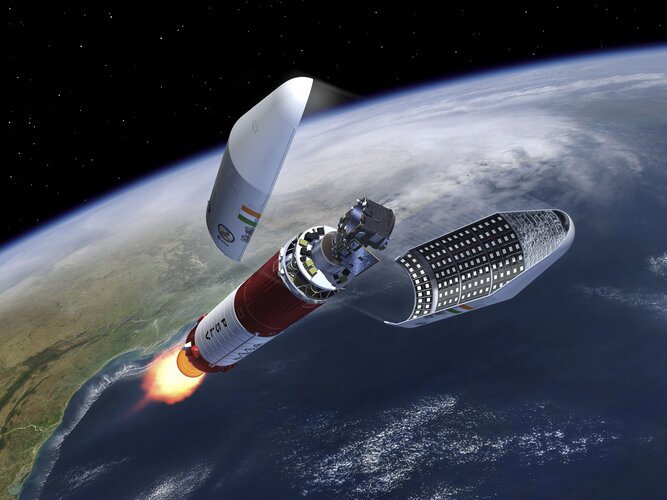Earth from Space: Clouds or snow?

 Image: These two images acquired by Copernicus Sentinel-2 highlight how the mission can help distinguish between clouds and snow.
Image: These two images acquired by Copernicus Sentinel-2 highlight how the mission can help distinguish between clouds and snow.
#news #space #science #esa #europeanspaceagency
posted by pod_feeder_v2

 Image: These two images acquired by Copernicus Sentinel-2 highlight how the mission can help distinguish between clouds and snow.
Image: These two images acquired by Copernicus Sentinel-2 highlight how the mission can help distinguish between clouds and snow.
#news #space #science #esa #europeanspaceagency
posted by pod_feeder_v2


The Proba-3 mission is set to demonstrate technologies needed for highly precise satellite formation flying, while also mapping the radiation content of the space through which it moves. The mission’s 3D Energetic Electron Spectrometer will measure electron fluxes as it passes through Earth’s radiation belts.
#engineering #technology #space #science #esa #europeanspaceagency
posted by pod_feeder_v2


Copernicus Sentinel-1
#earth #science #space #esa #europeanspaceagency
posted by pod_feeder_v2


Today, the European Space Agency signed six contracts that will help position Greece as a key player in the field of Earth observation.
#news #space #science #esa #europeanspaceagency
posted by pod_feeder_v2


ESA invites you to join its fifth Space for Inspiration conference on the future of commercial space exploration in Luxembourg on 4 and 5 December.
#human #space #science #esa #europeanspaceagency
posted by pod_feeder_v2
This is what Trump wants America to look like and smell like.
♲ Science Scholar - 2024-11-14 06:21:09 GMT
India's Capital Chokes on Toxic Smog 50 Times Above WHO Limit sciencealert.com/indias-capita… #science
https://climatejustice.social/@breadandcircuses/113477538393474961 breadandcircuses@climatejustice.social - Mother Nature says: FAFO
Trees and land absorbed almost no carbon dioxide (CO2) last year, and scientists are struggling to work out why.
Carbon sinks, such as forests, oceans and soils, are an essential part of regulating the Earth’s climate. Through natural processes, these land and ocean masses absorb almost half of all human carbon emissions from the atmosphere.
But preliminary findings for 2023 – the hottest year ever recorded on Earth – have found that the amount of carbon absorbed by forests, plants, and soil has temporarily collapsed.
This was completely unexpected, and therefore not something factored into most predictions and calculations about how quickly the Earth will heat up as a result of climate change. The breakdown of the land carbon sink could be temporary, but if it isn’t, this will drastically increase the rate of global heating.
It will be impossible for the world to reach net zero without carbon sinks, because there is simply no human technology that can absorb carbon on the same scale as the forests, grasslands, peat bogs, and oceans of the world.
#Science #Environment #Climate #ClimateChange #ClimateCrisis


We all know the frustration of settling down to watch something, only to spend more time staring at a buffering screen than enjoying the content. This common annoyance could soon be history, thanks to ESA's 5G-EMERGE project, which is combining satellite technology with 5G networks to revolutionise how we receive media content, particularly in areas where traditional internet connections struggle to deliver.
#telecommunications #space #science #esa #europeanspaceagency
posted by pod_feeder_v2

 Video: 00:06:45
Video: 00:06:45
Smile is the Solar wind Magnetosphere Ionosphere Link Explorer, a brand-new space mission currently in the making. It will study space weather and the interaction between the solar wind and Earth’s environment.
Unique about Smile is that it will take the first X-ray images and videos of the solar wind slamming into Earth’s protective magnetic bubble, and its complementary ultraviolet images will provide the longest-ever continuous look at the northern lights.
In this first of several short videos, David Agnolon (Smile Project Manager) and Philippe Escoubet (Smile Project Scientist) talk about the why and the how of Smile. You’ll see scenes of the building and testing of the spacecraft’s payload module by Airbus in Madrid, including the installation of one of the European instruments, the Soft X-ray Imager from the University of Leicester.
Smile is a 50–50 collaboration between the European Space Agency (ESA) and the Chinese Academy of Sciences (CAS). ESA provides the payload module of the spacecraft, which carries three of the four science instruments, and the Vega-C rocket which will launch Smile to space. CAS provides the platform module hosting the fourth science instrument, as well as the service and propulsion modules.
#news #space #science #esa #europeanspaceagency
posted by pod_feeder_v2

 Image: Getting Proba-3 fit for flight
Image: Getting Proba-3 fit for flight
#news #space #science #esa #europeanspaceagency
posted by pod_feeder_v2
Understanding Energy Use: The Challenge of Substituting Electrification https://www.youtube.com/watch?v=FO6MT419dHc
#science #globalheating


ESA is taking a significant step towards creating a more digitally inclusive Europe through a new partnership that will bring internet access to the hardest-to-reach areas. Reliable connectivity has become essential in today's digital age, yet for many Europeans in rural villages, mountainous regions, and small islands, dependable internet access remains out of reach.
#telecommunications #space #science #esa #europeanspaceagency
posted by pod_feeder_v2